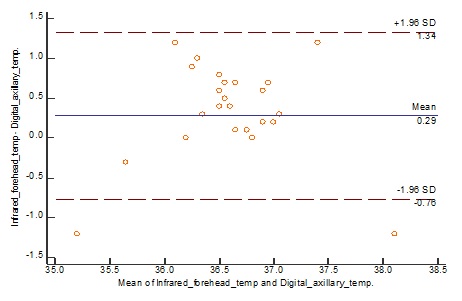Comparison of forehead infrared thermometry with axillary digital thermometry in detecting neonatal hypothermia & study of effects of early breast feeding and adequate clothing in maintaining neonatal temperature
Abstract
Background: Neonatal hypothermia is a well-recognized important contributing factor to neonatal morbidity and mortality especially in developing countries. Axillary thermometry is the conventionalmethod in neonates to measure body temperature. Forehead-infrared thermometry is new non-touch method that may reduce infection rate and discomfort of neonates.
Objectives: To compare the accuracy of forehead infrared thermometry with axillary digital thermometry in detecting neonatal hypothermia and to determine the association of inadequate clothes and delayed initiation of breastfeeding with increased risk of hypothermia.
Materials and Methods: A cross-sectional study was conducted among term neonates with age < 24 hrs of life in the postnatal wards of tertiary care hospital. The body temperature of neonates was measured by both methods & their accuracy was analyzed to detect hypothermia with the adequate statistical method. Association between delayed breastfeeding and inadequate clothing with neonatal hypothermia were also evaluated.
Result: Mean difference (bias) of the axillary and infrared forehead readings (-0.29°C) in the morning and (-0.31°C) in the evening. Agreement by the Bland-Altman method in the morning (-0.76 & 1.33) and at evening (-1.33 & 0.76) shows the transference of two techniques was inappropriate indicating that infrared-thermometry cannot replace axillary digital thermometry. Subjects who were early breastfed and with adequate clothing were found to have significantly higher body temperature.
Conclusion: Forehead infrared thermometry cannot replace axillary thermometry and is not recommended for neonatal temperature measurement. Early breastfeeding, covering of heads, as well as extremities, were found to be protective from hypothermia.
Downloads
References
2. Martin SA, Kline AM. Can there be a standard for temperature measurement in the pediatric intensive care unit? AACN Clin Issues. 2004 Apr-Jun;15(2):254-66.[pubmed]
3. Fortuna EL, Carney MM, Macy M, Stanley RM, Younger JG, Bradin SA. Accuracy of non-contact infrared thermometry versus rectal thermometry in young children evaluated in the emergency department for fever. Journal of Emergency Nursing. 2010 Mar 1;36(2):101-4.
4. Bland JM, Altman DG. Statistical methods for assessing agreement between two methods of clinical measurement. Lancet. 1986 Feb 8;1(8476):307-10.[pubmed]
5. Çınar ND, Filiz TM. Neonatal thermoregulation. Journal of Neonatal Nursing. 2006 Apr 1;12(2):69-74.
6. Forster DA, McLachlan HL. Breastfeeding initiation and birth setting practices: a review of the literature. J Midwifery Womens Health. 2007 May-Jun;52(3):273-80.[pubmed]
7. Sethi A, Patel D, Nimbalkar A, et al. Comparison of forehead infrared thermometry with axillary digital thermometry in neonates. Indian Pediatr. 2013 Dec;50(12):1153-4. Epub 2013 Jul 5.[pubmed]
8. Patel MS, Kakkad KM, Patel SV, et al. A comparative study of accuracy of non-contact infrared thermometry and axillary digital thermometry in neonates. Gujarat Med. J. 2014;69(2):103-4.
9. Placidi G, Merusi I, Gagliardi L. Rectal, axillary or skin temperature in newborns. J Preg Child Health. 2014;1(123):2.
10. Uslu S, Ozdemir H, Bulbul A, et al. A comparison of different methods of temperature measurements in sick newborns. Journal of Tropical Pediatrics. 2011 Jan 17;57(6):418-23.[pubmed]
11. Chiappini E, Sollai S, Longhi R, et al. Performance of non-contact infrared thermometer for detecting febrile children in hospital and ambulatory settings. J Clin Nurs. 2011 May;20(9-10):1311-8. doi: 10.1111/j.1365-2702.2010.03565.x.[pubmed]
12. EfijeniaKotsia, A. Attilakos, E. Tsekoura, et al. Temperature Assessment and Accuracy of Different Thermometer Devices in Neonates. International Journal of Nursing and Health Science Vol. 2, No. 6, 2015, pp. 64-69.
13. Mccall, Emma &Alderdice, Fiona & Halliday, Henry & Jenkins, John & Vohra, S. (2006). Interventions to prevent hypothermia at birth in preterm and/or low birthweight babies. Evidence‐Based Child Health: A Cochrane Review Journal. 1. 287 - 324. 10.1002/eb
14. Delavar MA, Akbarianrad Z, Mansouri MM, Yahyapour M. Neonatal hypothermia and associated risk factors at baby friendly hospital in Babol, Iran. Annals of medical and health sciences research. 2014;4(8):99-103.
15. Mullany LC, Katz J, Khatry SK, LeClerq SC, et al. Neonatal hypothermia and associated risk factors among newborns of southern Nepal. BMC Med. 2010 Jul 8;8:43. doi: 10.1186/1741-7015-8-43.[pubmed]
16. Raj JP, Sathish Kumar T. Prevalence of hypothermia among normal term neonates in a south Indian city and assessment of practice and knowledge risk factors among mothers–a hospital based cross-sectional study. 2015.

Copyright (c) 2019 Author (s). Published by Siddharth Health Research and Social Welfare Society

This work is licensed under a Creative Commons Attribution 4.0 International License.


 OAI - Open Archives Initiative
OAI - Open Archives Initiative


